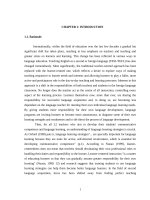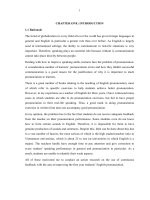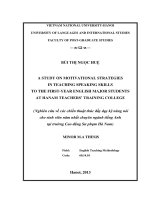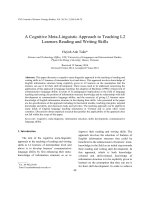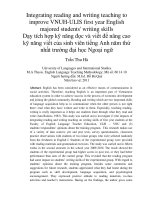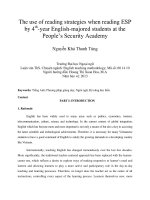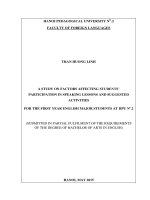Integrating reading and writing teaching to improve VNUH-ULIS first year English majored students' writing skills
Bạn đang xem bản rút gọn của tài liệu. Xem và tải ngay bản đầy đủ của tài liệu tại đây (172.98 KB, 14 trang )
Integrating reading and writing teaching to
improve VNUH-ULIS first year English
majored students' writing skills
Dạy tích hợp kỹ năng đọc và viết để nâng cao
kỹ năng viết của sinh viên tiếng Anh năm thứ
nhất trường đại học Ngoại ngữ
Trần Thu Hà
University of Languages and International Studies
M.A Thesis. English Language Teaching Methodology; Mã số: 60 14 10
Người hướng dẫn: M.Ed. Đỗ Bá Quý
Năm bảo vệ: 2011
Abstract. English has been considered as an effective means of communication in
social activities. Therefore, teaching English is an important part of Vietnamese
education system in order to achieve success in the process of economic development
and joining the global community. Reading and writing which are two important skills
of language acquisition help us to communicate when the other person is not right
there: read what they have written and write to them. Especially, teaching reading-
writing is really important as it helps our students learn through what they read and
write (Ann Raimes, 1983). This study was carried out to investigate (1) the impacts of
integrating reading and writing teaching on writing skills of first year students at the
Faculty of English Language Teacher Education, ULIS – VNU and (2)
students’/respondents’ opinions about the training program. This research makes use
of a variety of data sources: pre and post tests, survey questionnaires, classroom
practice observations with students of two intact groups who were selected randomly
from the freshmen in English I. Students of the experimental group were provided
with reading materials and grammatical exercises. The study was carried out in fifteen
weeks in the second semester in the school year 2009-2010. The result showed the
students of the experimental group had higher scores in post test, or they had better
performance than ones of the control group. This revealed that the reading program
had some impact on students’ writing skills of the experimental group. With regard to
students’ opinions about the training program, besides some comments and
suggestions for future research, students appreciated what they had learnt during the
program such as skill development, language acquisition, and psychological
encouragement. They expressed positive attitude to reading materials, in-class
activities and teacher’s instructions. Basing on the findings, the author gives some
pedagogical implications to improve the process of teaching and learning English as a
foreign language and teaching and learning writing skill in particular.
Keywords. Kỹ năng đọc; Phương pháp giảng dạy; Tiếng Anh; Kỹ năng viết
Content.
This part is dedicated to introducing the rationale of the study, the problem to be
addressed in the study, the aims and the objectives of the study, and the research
questions to be answered. It will also present the scope of the study, an overview of the
employed methods, and the design of the study.
1. Statement of the problem and rationale for the study
English teachers often ask themselves what their students’ problems are and how they
can help their students. One of the sources which allows teachers to know more about
their students’ difficulties is students’ test results. The author has realized that her
students’ performance of achievement tests is very poor, especially students’ bad
performance of writing tests. The most frequent answer of students when asked about
difficulties in writing is that they cannot express their ideas in English and they find it
hard to choose a suitable word or structure in order to make their writing sound
English. One of the most frequently-made errors relates to the use of unsuitable
expressions; moreover, students’ writing pieces are affected seriously by their mother
tongue. It is clear that students do not have adequate knowledge of sets of vocabulary,
grammatical structure, culture, etc. Thus, they encounter difficulties in writing and
cannot produce creative writing works.
With the purpose of improving the above situation, the author decided to do research
on the topic “Integrating Reading and Writing Teaching to Improve VNUH University
of Languages and International Studies First-year English-majored Students’ Writing
Skills”.
Providing supplementary reading materials was believed to bring students the best
progress in a short time because first year students lack background knowledge.
Reading passages and doing supplementary exercises give them a chance to acquire
target language and cultural knowledge, sets of vocabulary and structures as well to
help students write better. However, this method of teaching and learning also has
some shortcomings, for example the preparations, teaching techniques, syllabus,
students’ assessment, etc.
In L2 literacy contexts, Krashen's (1984) argument that “it is reading that gives the
writer the 'feel' for the look and texture” (p.20, cited in Hirvela, 2004) paves the way
leading writing researchers and instructors to the vision of reading/writing connection.
He claims that reading, which builds the knowledge base of written texts, helps L2
learners acquire necessary language constructs such as grammatical structures and
discourse rules for writing, and facilitates the process of language acquisition.
The author is always interested in studying writing instructions and has received the
permission and support of the faculty and colleagues; therefore, this study has been
motivated. It is hoped to provide educators and teachers with a clearer insight into how
the theories of integration of reading and writing can influence and correspond to
actual classroom practices.
2. Objectives of the study
Firstly, this study is carried out to investigate the theories and findings of the earlier
studies and provide more empirical evidence for the effects of integration of reading
and writing on learners’ writing performance to support the tendency of integrated
skills teaching in the context of Vietnam and the author’s workplace. Secondly, it is an
attempt to meet the needs of the first year students in University of Foreign Languages
and International Studies (ULIS) to improve their writing ability. Thirdly, it is
expected that the results of the study would be useful in some ways for teachers and
educators in university who are teaching reading and writing at the same time or
anyone who is interested in this field of the English language teaching. Finally, the
study is aimed at providing more information for the trend of integrating skills to teach
English language learners in the division.
This study specially has the following objectives:
1. Investigating the effects of the integrated reading and writing instruction
program on first year students’ writing performance in EFL settings.
2. Investigating the students’ opinions about the integrated reading and writing
instruction program.
3. Offering some practical recommendations for improvement of first year
students’ writing skills at English I.
3. Research questions of the study
In order to achieve the above-mentioned objectives, the research questions of the study
are set out as follows:
(1) Is there a difference between the writing performance scores of the control group
and those of the experimental?
(2) What are the students’ opinions of the integrating reading and writing instruction
program and their suggestions for future research?
The study was conducted to test the following research hypotheses:
H
0
:
There is no difference in writing performance between students who take part in the
integrated reading and writing instruction program and those who do not.
H
1
:
Students who take part in the integrated reading and writing instruction program will
make more progress in writing proficiency test than those who do not participate in
such a program.
4. Scope of the study
This study focuses on the present context at English I, Faculty of English Language
Teacher Education, University of Languages and International Studies, Vietnam
National University, Hanoi (FELTE, ULIS,VNUH). This study investigates the impact
of the program of integrating reading and writing teaching on first year students’
writing performance in 15 weeks. These students’ writing proficiency was measured in
correlation to the application of an experimental reading – writing integration program.
5. Methods of the study
The research method employed in this study is a quasi-experimental design to propose
the research questions and to find out the answers. The method involves the three basic
components of experiments as presented by Selinger and Shohamy, that is, the
population (ULIS first year students), the treatment (the program of integrating reading
and writing instruction) and the measurement of the treatment (t-test) (1989, p.136). It
is conducted with the participation of 52 first year students. Data collection
instruments include pre and post tests, and a survey questionnaire. More details can be
seen in Chapter 3.
6. Design of the study
This study consists of five chapters. Chapter 1 introduces the research topic, the
rationale for it and provides the aims, the scope, the method, and the research questions
as well. Chapter 2 has an overview of the literature on the field of writing and
integration of reading and writing teaching. Chapter 3 describes the methodology of
the study including information about the respondents, data collection instruments and
the procedure of data collection and analysis. Chapter 4 presents the results of tests and
survey questionnaire. Chapter 5 discusses the findings, draws conclusions, provides
pedagogical implications, discusses the limitations of the study and provides some
suggestions for further research.
In this chapter, the author has mentioned the rationale, the scope and the objectives of
the study. The research questions are also presented as well as the employed methods
and design of the study. In the next chapter, she is going to review the relevant
literature to provide a theoretical framework for the study.
References.
Abraham, P. (2002). Skilled Reading: Top-down, bottom-up. Retrieved on Oct 12, 2009
from resources/ fieldnotes/vol10/fn102.pdf
Ailing, K. (2006). Connections between L1 and L2 Readings: Reading Strategies Used
By Four Chinese Adults Readers. Asian Journal, Vol. 6, No. 2.
Anderson, R.C., Hiebert, E.H., Scott, J.A. and Wilkinson, I.A.G. (1985). Becoming a
nation of readers. Washington, DC: US Department of Education, the National
Institute of Education.
Alderson, J.C & Urquhart, A.H. (1986). Reading in a Foreign Language. New York:
Longman.
Alexander, L.G. (1967). Developing Skills. Longman.
Allington, R.A. (1998). Teaching Struggling Readers: Articles from The Reading
Teacher. Retrieved on 28
th
October 2009 from
Allington, R.L. & Cunningham, Patricia, M. (1998). Classrooms That Work: They Can
All Read and Write. NY: Addison-Wesley Educational Publishers.
Armbruster, B.B., & Anderson, T.H. (1982). Idea-mapping: The technique and its use
in the classroom (Reading Education report no.36). Urbana: University of
Illinois, Center for the Study of Reading.
Badger, R., & White, G. (2000). Product, process and genre: Approaches to writing.
EAP, ELT Journal, 54(2), 153-160
Barnwell, W.H., & Dees, R. (1996). The resourceful writer: A basic writing course (3
rd
ed.). USA: Houghton Mifflin Company.
B-Ikeguchi, C. (1997). About: Teaching Integrated Writing Skill. Retrieved on 28
th
October 2009 from
Boughey, C. (1997). Learning to write by writing to learn: a group – work approach.
ELT Journal, v51 n2 p126-34.
Brown, K. & Hood, S. (1992). Writing Matters. Cambridge: Cambridge University
Press.
Brown, H.D. (1994). Principles of Language Learning and Teaching. 3
rd
ed. Prentice
Hall Regents.
Brumfit, C.J., Johnson, K. (1979). The Communicative Approach To Language
Teaching. Oxford: Oxford University Press.
Brumfit, C.J. (1984). General English Syllabus Design. Oxford: Pergamon.
Burns, R.B. (2000). Introduction to Research methods. London: Sage Publications.
Byrne, D. (1991). Longman Handbooks for Language Teachers: Teaching Writing
Skills. UK: Longman.
Carson, J. (1993). Reading for writing. In J. Carson, & I. Leki (Eds), Reading in the
composition classroom: Second language perspectives. Boston: Heinle & Heinle.
Carrel, Patricia, L. & Eisterhold, J.C. (1983). Schema theory and ESL reading
pedagogy. TESOL Quarterly, v17 n4 p.552-573.
Caverly, D.C. (2009). Handbook of College Reading and Study Strategy Research, 2
nd
edition. New York: Routledge Publisher.
Chen, Y. (2006). Using Children’s Literature for Reading and Writing Stories. Asian
EFL Journal, v8 n4 p.210-232.
Clark, I. et al. (2003). Concepts in composition, theory and practice in the teaching of
writing. London: Lawrence Erlbaum associates publishers.
Celce-Murcia, M. (2001). Teaching English as a second or foreign language (3
rd
ed.).
MA: Heinle & Heinle.
Cohen, L., Manion L., & Morrison K. (2007). Research Methods in Education, 6
th
edition. London and New York: Routledge.
Cummins, J. (1986). Language proficiency and academic achievement. In Cummins
and Swain.
Day, R. & Bamford, J. (2002). Top Ten Principles for Teaching Extensive Reading.
Retrieved on 28
th
October 2009 from
De Ford, D.E. (1986). Classroom contexts for literacy learning. In T.E. Raphael (ed.).
The contexts of school-based literacy. New York: Random House.
De Barros, J. (1990). Storytelling project. Southeast Asian women’s alliance. ERIC:
ED 359838.
Dornyei, Z. (2003). Questionnaires in Second language research: Construction,
Administration, and Processing. Lawrence Erlbaum.
Dressman, M., & Webster, J. P. (2001). Retracing Rosenblatt: A textual archaeology.
Research in the Teaching of English, 36, 110-145.
Drucker, M.J. (2003). What reading teachers should know about ESL learners. The
reading Teacher. ELT journal v57 n1 p.22-29. Retrieved on Sep 2, 2009 from
www.questia.com
Edge, J. (1989). Mistakes and Correction. Harlow: Longman.
Elbow, P. (1973). Writing Without Teachers. Oxford: Oxford University Press.
Fischer, S.R. (2003). A History of Writing. London: Reaktion Books.
Foertsch, M. (1997). Exemplary reading programs in Illinois public schools. Oak
Brook, IL: North Central Regional Education Laboratory. Retrieved on 28
th
October 2009 from sdrs/areas/isbe/titlepg.htm
Foertsch, M. (1998). A study of reading practices, instruction, and achievement in
District 31 schools. Oak Brook, IL: North Central Regional Education
Laboratory. Retrieved on 28
th
October 2009 from
Freedman, M. (1991). Writing for language acquisition in beginning and low-literacy
adult ESOL classes. Retrieved on Oct 10, 2009 from
Galda, L. (1988). Readers, texts, and contexts: A response-based view of literature in the
classroom. The New Advocate, 1, 92-102.
Gardner, R. C. & Lambert, W. E. (1972). Attitudes and motivation in second language
learning. Rowley, MA: Newbury House.
Goodman, K. (1986). What’s whole in whole language? Portsmouth, N.H.: Heinemann.
Grabe, W. & Robert B. Kaplan (1996). Theory and Practice of Writing. Longman.
Graham, S., & Harris, K.R. (1993). Improving the writing of students with learning
problems: Self-regulated strategy development. School Psychology Review,
v22 n4 p.656-671.
Hancock, M. R. (2004). A celebration of literature and response: Children, books, and
teachers in K-8 classrooms (2
nd
ed.). Ohio: Pearson Education.
Hansen, J. G & Liu, J. (2005). Guiding principles for effective peer response. ELT
journal, 59/1, 31-38, Oxford: Oxford University Press.
Hafiz, F.M. & Tudor, Ian. (1989). Extensive reading and the development of language
skills. ELT Journal, v43 n1 p4-13.
Haller, Lee. (2000). Modeling class activities for low-level literacy learners. Field
Notes, v10 n2; Fall 2000. Retrieved on Sep 20, 2009 from
Harmer, J. (2001). The Practice of English language teaching, 3
rd
ed. Harlow:
Longman.
Hashemi, L. & Thomas, B. (2004). Cambridge Practice Test For PET. Oxford: Oxford
University Press.
Hedge, T. (2000). Teaching and learning in the classroom. Oxford: Oxford University
Press.
Hedge, Tricia. (2003). Teaching & learning in the language classroom. UK: OUP.
Heller, M.F. (1999). Reading-writing connections: From theory to practice (2
nd
ed.).
Mahwah, NJ: Erlbaum.
Henry, J. (1995). If not now: Developmental readers in the college classroom.
Portsmouth, NH: Boynton/Cook, Heinemann.
Hickman, J. (1981). A new perspective on response to literature: Research in an
elementary school setting. Research in the Teaching of English, 15, 343-354.
Hirvela, A. (2004). Connecting Reading and Writing in Second Language Writing
Instruction. University of Michigan Press.
Hu, M. & Nation, P. (2000). Unknown vocabulary density and reading comprehension.
Reading in a Foreign Language, v13 n1, p.403-430.
Jiang, C. & Du, H. (2006). Integrating Reading and Speaking with Writing in College
English Teaching. ELT Journal, v3 n3 p37-40
Jolly, D. (1984). Writing Tasks. Cambridge: Cambridge University Press.
Kay, S., Jones, V. & Kerr, P. (2009). Inside Out Pre-intermediate. Macmillan.
Kelly, H. (1997). How Children Learn To Derive Meaning from Text. Retrieved from
Lannon, J.M. (1989). The Writing Process: A Concise Rhetoric. Glenview: Scott,
Foresman and Co.
Lecturers at Division 1, FELTE, ULIS – VNU. (2006). Writing Focus. Hanoi: Vietnam
National University Press
Lenneberg, E.H. (1967). The Biological Foundations of Language. John Wiley and
Sons.
Lindemann, E. (1995). A rhetoric for writing teachers (3rd ed.). New York & Oxford:
Oxford University Press.
Loranc-Paszylk, B. (2009). Integrating Reading and Writing into the Context of CLIL
Classroom: Some Practical Solutions. Retrieved on 28
th
October 2009 from
Maley, A. (1999). Surviving the 20th century. English Teaching Professional. EFL
Journal, issue 10, p.3-7.
Many, J. E. (1991). The effects of stance and age level on children’s literary responses.
Journal of Reading Behavior, 23, 61-85.
Markstein, L. & Hirasawa, L. (1994). Developing Skills. Heinle & Heinle Publishers.
Moss, B., Leone, S., & DiPillo, M. L. (1997). Exploring the literature of fact: Linking
reading and writing through information trade books. Language Arts, 74, 418-
429.
Newman, J. (1985). Whole language: Theory in use. Portmouth, NH: Heinemann.
Nunan, D. (1988). Designing tasks for the communicative classroom. Cambridge:
Cambridge University Press.
Nunan, D. (1998). Syllabus Design. Oxford, Oxford University Press.
Nunan, D. (2003). Practical English Language Teaching. New York: McGraw-Hill
Contemporary.
Nunan, D. (1992). Research Methods in Language Learning. Oxford: Oxford
University Press.
Nuttall, C. (1996). Teaching reading skills in a foreign language (2nd ed.). Oxford:
Heinemann.
Opitz, M. F. & Ford, M. P. (2001). Reaching readers: Flexible & innovative strategies
for guided reading. NH: Heinemann.
Orasanu, J. (Ed.). (1986). Reading comprehension: From research to practice. Hillsdale,
NJ: Lawrence Erlbaum Associates.
Oxenden,C., Latham-Koenig, C, & Seligson, P. (2007). New English File. Oxford:
Oxford University Press.
Paran, A. (1996). Reading in EFL: facts and fictions. ELT Journal v50 n1 p.25-34.
Person, P.D., & Leys, M. (1985). Teaching comprehension. In T.L. Harris & E.
Cooper (Eds.). Reading, thinking, and concept development. New York: The
College Board.
Prabhu, N.S. (1987). Second Language Pedagogy. Oxford, Oxford University Press.
Quinn, E. & I.S.P Nation (1991). Speed Reading A Course for Learners of English.
Victoria University of Wellington.
Rabideau, D. (1993). Integrating Reading and Writing into Adult ESL Instruction.
National Clearinghouse on Literacy Education Washington DC.
Raimes, A. (1983). Techniques in teaching writing. Oxford: Oxford University Press.
Resnick, J. & Lester, L. (2000). Text & Thought, An Integrated Approach to College
Reading & Writing. Longman: Addison-Wesley Educational Publisher.
Rosow, L. (1990). Consumer advocacy, empowerment, and adult literacy. Journal of
Reading, 34(4), 258-262.
Salkind, N. & Rasmussen, K. (Eds.) (2006). The Encyclopedia of Measurement and
Statistics Vol 2. (pp. 452-453). Sage Publications; Thousand Oaks, California
Samuels, S. J. (1991). Ten best ideas for reading teachers. In E. Fry (Ed.), Ten best
ideas for reading teachers (pp. 17-20). Menlo Park, Calif.: Addison-Wesley.
Suleiman, H. (2005). Teaching reading comprehension to ESL/EFL learners. Retrieved
on 28
th
October 2009 from www.asian-efl-journal.com
Selinger, H. & Shohamy, E. (1989). Second Language Research Methods. Oxford
University Press.
Shuhua, T., Zhang, L.J & Yuanxing, D. (2009). Integrating Cooperative Learning into
Genre-based Teaching of EFL Writing. Retrieved on 28
th
October 2009 from
www.asian-efl-journal.com/
Shuying, Y. (2002). About: Integrating Reading with Writing. Retrieved on 28
th
October 2009 from
Squire, J.R. (1984). Composing and comprehending: Two sides of the same basic
process. In J.M. Jensen (Ed.). Composing and comprehending. Urbana, IL:
National Conference on Research in English.
Stoicheva, M. (1999). Balanced Reading Instruction. ERIC Clearinghouse on Reading
English and Communication Bloomington IN.
Tierney, R. J., & Pearson, P. D. (1983). Toward a composing model of reading.
Language Arts, 60, 568-580.
Tierney, R.J., & LaZansky, J.M. (1980). The rights and responsibilities of readers and
writers: A contractual agreement. Language Arts, 57, 606-613.
Tierney, R.J., & Shanahan, T. (1996). Research on the reading-writing relationship:
Interactions, transactions, and outcomes. In R. Barr, M.L. Kamil, P.B.
Mosenthal, & P.D. Pearson (Eds.), Handbook of reading research: Volume II
(pp. 246-280). White Plains, NY: Longman.
The Little Red Reading Book: Research on Reading Instruction. (1997). Illinois State
Board of Education.
Thompson, M. (1988). Extensive reading-acquiring the reading habit? Presentation
given at JALT Kyoto chapter, Kyoto, Japan.
Tribble, C. (1996). Writing. Oxford: Oxford University Press.
Wallace, M.J (1989). Study Skills in English. Cambridge: Cambridge University Press.
Zamel, V. (1982). Writing: the process of discovering meaning. TESOL Quarterly v16
n7 p195-209.
Zemach, D.E. & Islam, C. (2004). Paragraph Writing – From Sentence To Paragraph.
Macmillan.
Zemach, D.E. & Rummisek, L.A. (2006). Academic Writing – From Paragraph To
Essay. Macmillan.
Zhang, Z. (1993). Literature review on reading strategy research. Retrieved on Sept
10, 2009 from EDRS database (ED356643).
